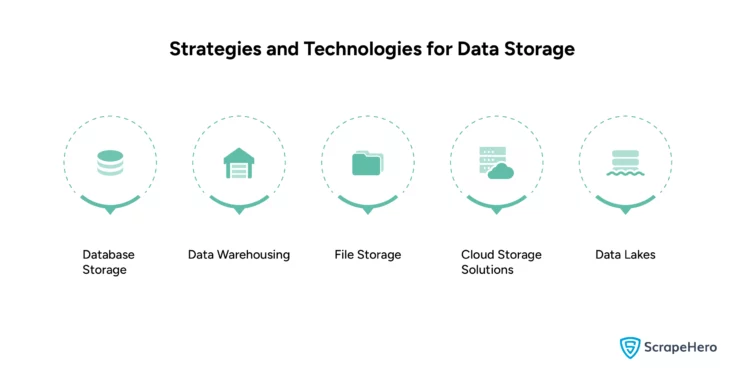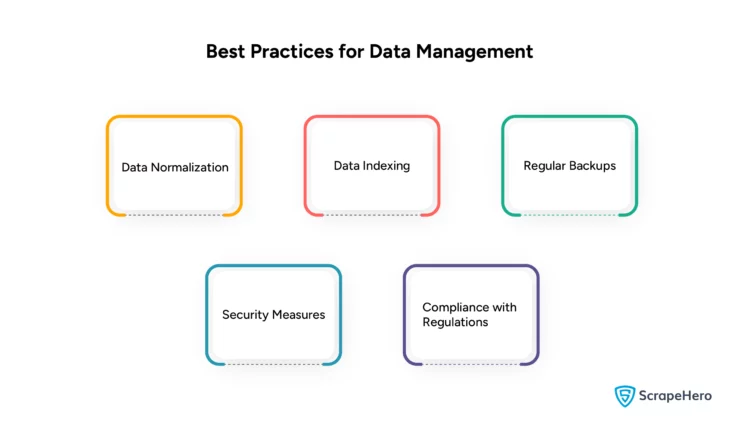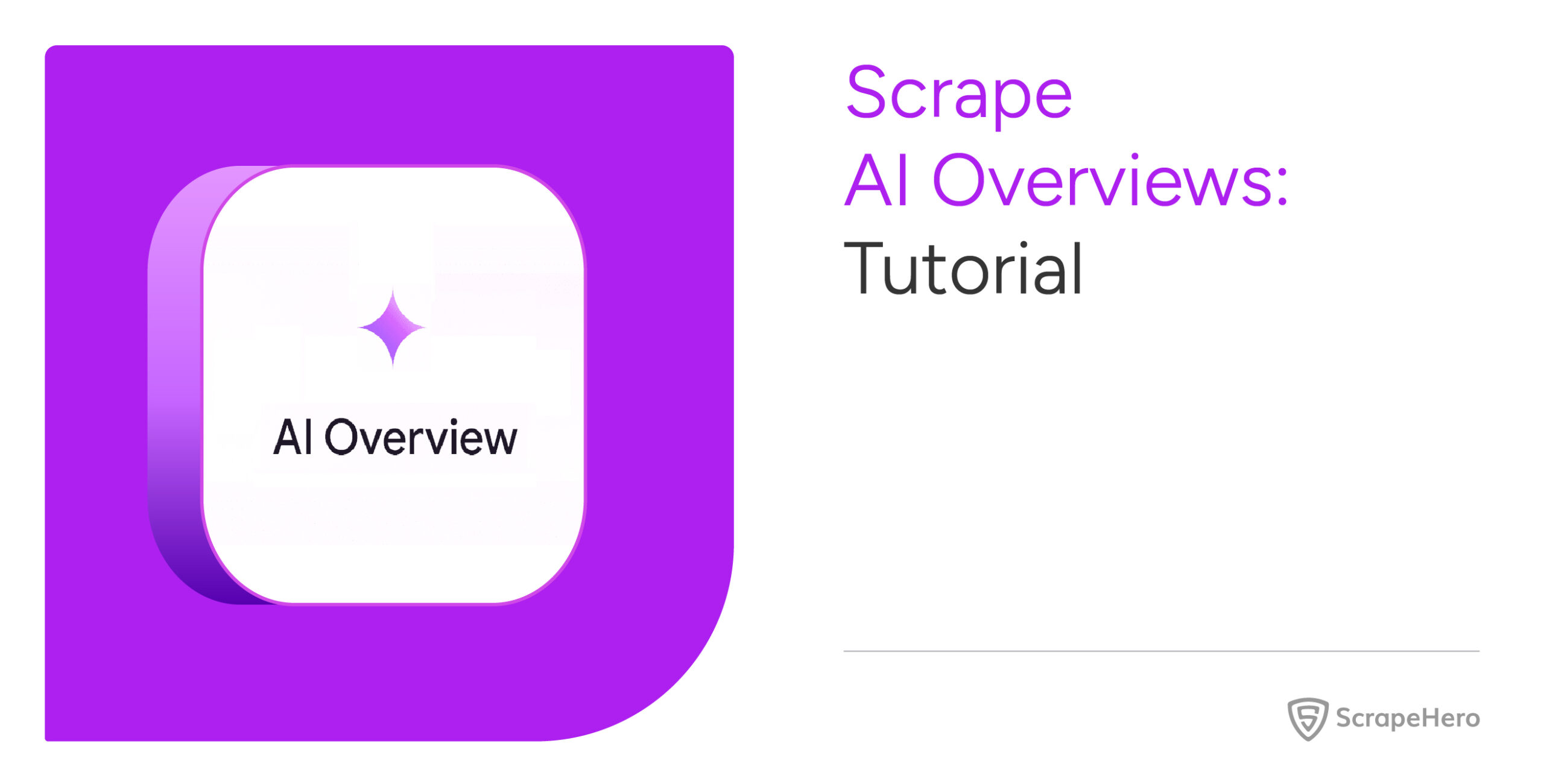Storing and managing data from websites after scraping involves many steps, from organizing the data into a structured database to updating it as necessary.
By implementing proper data storage and management, you can significantly enhance data integrity, facilitate ease of access, and optimize performance, thereby maximizing the value of your scraped data.
This article discusses some of the standard and efficient ways of storing scraped data and some best practices for data management.
Strategies and Technologies for Data Storage After Web Scraping

Listed are some of the prominent strategies and technologies you might consider for storing your scraped data:
1. Database Storage
Database storage is storing data in structured formats using management systems that support complex queries. They are divided into:
-
Relational Databases
A relational database, Relational Database Management System (RDBMS), or SQL database stores data in tables with predefined relationships.
- MySQL, PostgreSQL
These storages are suitable for structured data and complex queries.
They ensure data integrity and consistency through ACID (Atomicity, Consistency, Isolation, Durability) compliance for transaction-heavy applications. - SQLite
SQLite is apt for smaller and lightweight applications without a server setup.
Since it supports subsets of SQL standards, it’s an excellent choice for mobile or small desktop applications.
- MySQL, PostgreSQL
-
NoSQL Databases
NoSQL databases are flexible databases designed for unstructured and semi-structured data.
Do you know that you can parse unstructured addresses using Python? Find out how.- MongoDB
MongoDB efficiently handles unstructured and semi-structured data because of its flexibility and document-oriented approach.
MongoDB is especially beneficial in situations where the schema may change over time. - Cassandra, DynamoDB
These databases are well-suited for large-scale, distributed data environments.
They are ideal for highly available applications as they provide scalability and reliability across multiple servers and data centers.
- MongoDB
2. Data Warehousing
Data warehousing is a specialized system that stores and analyzes large amounts of data. It is more used for query and analysis than transaction processing.
Amazon Redshift, Google BigQuery
They are platforms that can manage massive quantities of data and complex queries.
They are helpful for data analytics and business intelligence applications and support extensive data manipulation.
3. File Storage
File storage is a data storage method in which data is stored in files and folders, making it easily accessible and manageable across various systems.
-
CSV, JSON Files
These file formats are simple and effective for small to medium-sized datasets that require easy sharing or frequent interoperability with different systems.
Due to their broad compatibility across platforms, they are used universally for data storage.
Learn to visualize location data from a CSV file as a choropleth map in QGIS. -
Parquet, ORC
These columnar storage formats can handle large datasets due to their efficient compression and encoding schemes.
They can enhance the efficiency of read-write operations and query performance.
4. Cloud Storage Solutions
Cloud storage solutions are services vendors provide to store data on remote servers accessible from the internet.
These types of storage can offer scalability, reliability, and global access.
AWS S3, Google Cloud Storage, Azure Blob Storage
These cloud platforms are highly scalable and durable storage solutions. Their use cases include backup, archival, and serving as a repository for analytics (data lakes).
They are secure and ensure data availability and disaster recovery options.
5. Data Lakes
Data lakes are storage repositories that hold vast amounts of raw data in their native format. It can support flexible schemas for data analysis and discovery.
Apache Hadoop, Azure Data Lake
These solutions can store vast amounts of raw data in their native format. They are helpful when data processing and analysis needs to be fully defined.
They also support a wide range of analytical and machine-learning applications.
Best Practices for Data Management After Web Scraping

Given are some practices you should follow to manage the data after storing them:
1. Data Normalization
Normalization, database normalization, or data normalization involves organizing the fields and tables of a database.
It ensures that the database is free of redundancy and inconsistency, improving the speed and accuracy of the database.
2. Data Indexing
Indexing is a vital process in database management. It improves the speed of data retrieval operations by efficiently locating data.
Since it doesn’t scan every database table row, it improves performance for read-intensive operations.
3. Regular Backups
Regular backups are required to ensure that data is not permanently lost in case of software or hardware failures or data corruption.
The backups are scheduled at regular intervals and tested frequently for effective recovery capability.
4. Security Measures
To protect sensitive data scraped from websites, it is essential to implement encryption of data at rest and in transit.
It is also vital to access controls to ensure that only authorized personnel have data access, and regular security audits to identify and mitigate vulnerabilities.
5. Compliance with Regulations
Compliance with legal regulations is vital depending on the nature of the data collected and the geographic location of the operation.
Compliance with legal regulations includes legal standards and other relevant data protection laws to ensure the ethical handling of scraped data.
Tools for Data Management
-
ETL (Extract, Transform, Load) Tools
ETL tools help in automating the process of extracting data from various sources, including databases and spreadsheets.
It is also used to transform data into a suitable format involving cleansing, sorting, and loading it into a data store.
-
Data Orchestration Tools
To design and execute complex workflows for data processing, tools such as Apache Airflow, Luigi, and Prefect are used.
These tools ensure that tasks are performed efficiently and in the correct order.
Monitoring and Maintenance
Regular Updates
It is essential to keep the data storage and management tools up-to-date.
Regular updates can ensure that systems are protected against vulnerabilities, thus improving performance and enhancing efficiency.
Monitoring Tools
To monitor data storage performance, you can use tools like Prometheus, Grafana, and Elasticsearch.
Prometheus collects and stores metrics as time-series data, while Grafana visualizes those metrics through dashboards.
Elasticsearch searches, monitors, and analyzes log files in real-time.
Wrapping Up
Even when numerous options exist to save and manage the data scraped from various sites, it still poses challenges.
These challenges may include ensuring that the data is up-to-date and accurate and handling the large volume and diversity of data formats.
When ethical and legal aspects of web scraping are involved, the situation becomes more complex.
Such situations demand the support of an experienced data service provider like ScrapeHero.
With a decade of expertise in web scraping services, we offer our customers complete data pipeline processing, from data extraction to custom robotic process automation.
Frequently Asked Questions
You can use Python libraries such as csv to store scraped data in a CSV file.
Use the Pandas library in Python to create a DataFrame from scraped data and then use the .to_excel() method to save it as an Excel file.
The best database for scraped data depends on the data structure and scale.
However, MongoDB is generally considered an excellent choice for unstructured data, and PostgreSQL is ideal for structured data requiring complex queries.
To store scraped data into databases you need to format the data into a suitable structure and then use a DBMS with appropriate SQL or NoSQL commands.
You can use libraries such as SQLAlchemy or PyMongo in Python to automate this process.
Standard methods for exporting scraped data include using programming libraries like csv and Pandas to save data directly into different formats for further processing.
We can help with your data or automation needs
Turn the Internet into meaningful, structured and usable data








